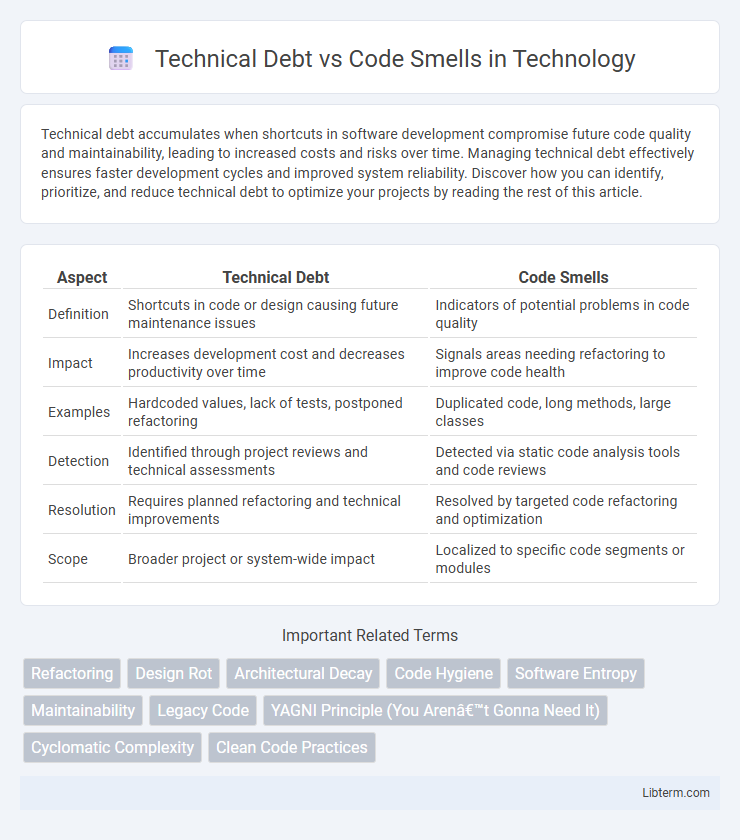Technical debt accumulates when shortcuts in software development compromise future code quality and maintainability, leading to increased costs and risks over time. Managing technical debt effectively ensures faster development cycles and improved system reliability. Discover how you can identify, prioritize, and reduce technical debt to optimize your projects by reading the rest of this article.
Table of Comparison
| Aspect | Technical Debt | Code Smells |
|---|---|---|
| Definition | Shortcuts in code or design causing future maintenance issues | Indicators of potential problems in code quality |
| Impact | Increases development cost and decreases productivity over time | Signals areas needing refactoring to improve code health |
| Examples | Hardcoded values, lack of tests, postponed refactoring | Duplicated code, long methods, large classes |
| Detection | Identified through project reviews and technical assessments | Detected via static code analysis tools and code reviews |
| Resolution | Requires planned refactoring and technical improvements | Resolved by targeted code refactoring and optimization |
| Scope | Broader project or system-wide impact | Localized to specific code segments or modules |
Understanding Technical Debt: A Comprehensive Overview
Technical debt represents the long-term consequences of prioritizing speed over code quality in software development, leading to increased maintenance costs and reduced agility. Unlike code smells, which are specific signs of potential issues in the codebase, technical debt encapsulates the broader impact of shortcuts and suboptimal solutions on project timelines and scalability. Properly managing technical debt requires identifying root causes, assessing its evolution, and implementing strategic refactoring to balance immediate delivery with sustainable software health.
Defining Code Smells: What Are They?
Code smells refer to patterns in source code that indicate potential problems or weaknesses affecting maintainability and readability without necessarily causing immediate bugs. These symptoms often point to deeper design or architectural issues, such as duplicated code, large classes, or long methods, which can increase technical debt if left unaddressed. Identifying code smells early helps developers refactor and improve code quality, reducing future costs and complexity associated with software maintenance.
Key Differences Between Technical Debt and Code Smells
Technical debt refers to the long-term consequences of expedient software development decisions that compromise code quality for speed, whereas code smells are specific symptoms within the code indicating deeper underlying problems. Technical debt impacts project timelines, maintainability, and scalability by accumulating over time, while code smells serve as immediate indicators that certain code sections may require refactoring or optimization. Understanding that technical debt encompasses strategic compromises affecting the entire system contrasts with code smells, which are localized issues detectable through code analysis tools.
Common Causes of Technical Debt in Software Projects
Common causes of technical debt in software projects include rushed deadlines, incomplete documentation, and inadequate testing procedures. Frequent changes in requirements and lack of proper refactoring lead to accumulating code smells such as duplicated code, large classes, and long methods. Poor initial design decisions and insufficient code reviews further exacerbate the buildup of technical debt, reducing maintainability and increasing future development costs.
Typical Examples of Code Smells in Real-World Codebases
Typical examples of code smells in real-world codebases include duplicated code, long methods, and large classes that hinder maintainability and scalability. Other common issues are excessive comments indicating unclear logic, feature envy where functions excessively interact with data from other classes, and shotgun surgery characterized by multiple small changes scattered across various parts of the code. These code smells often signal underlying technical debt, leading to increased development costs and reduced software quality over time.
How Technical Debt Impacts Software Quality and Maintenance
Technical debt accumulates when shortcuts in coding or design are chosen over best practices, directly reducing software quality by increasing the likelihood of defects and system failures. This debt complicates maintenance tasks, requiring more time and resources to refactor, debug, or extend the software, thus slowing down future development cycles. Persistent technical debt leads to degraded codebase health, causing higher costs and delays in delivering new features while negatively affecting overall system reliability and performance.
The Role of Code Smells in Project Health Assessment
Code smells serve as early indicators of technical debt, highlighting problematic areas in the codebase that may hinder maintainability and scalability. By systematically identifying code smells such as duplicated code, long methods, or large classes, development teams can prioritize refactoring efforts to reduce technical debt accumulation. Monitoring code smells provides a measurable way to assess project health, guiding decision-making towards improved code quality and sustainable software development.
Strategies for Identifying and Measuring Technical Debt
Strategies for identifying and measuring technical debt involve code analysis tools, static code analysis, and continuous integration metrics that highlight deviations from coding standards or architectural guidelines. Prioritizing issues based on impact, frequency, and complexity facilitates targeted debt reduction, while using qualitative assessments from code reviews complements quantitative data. Leveraging project management tools to track debt items and integrating technical debt awareness into sprint planning enhances overall code quality and maintainability.
Effective Approaches to Addressing Code Smells
Addressing code smells effectively involves identifying patterns that indicate poor design or implementation, such as duplicated code, long methods, or large classes. Refactoring techniques, including extracting methods, reducing class size, and improving naming conventions, help enhance code readability and maintainability while preventing the accumulation of technical debt. Incorporating static code analysis tools and continuous code reviews enables early detection and systematic resolution of code smells, promoting healthier codebases and sustainable software development.
Best Practices for Preventing Technical Debt and Code Smells
Implementing code reviews and automated testing significantly reduces technical debt and code smells by ensuring code quality and maintainability. Adopting continuous refactoring practices helps identify and eliminate code smells early, preventing accumulation of technical debt. Leveraging static code analysis tools provides actionable insights for maintaining clean, scalable codebases aligned with industry best practices.
Technical Debt Infographic

 libterm.com
libterm.com